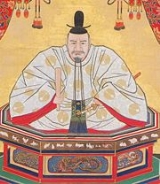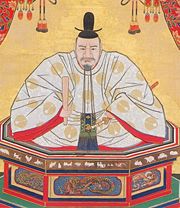
Nabeshima Naoshige
Encyclopedia

a retainer of the Ryūzōji clan
Ryuzoji clan
The was a Japanese clan which claimed descent from Fujiwara Hidesato. It came to prominence in the Sengoku period, in the fighting in northern Kyūshū. Their descendants became retainers of the Matsudaira clan of Aizu, and remained there until the Meiji Restoration...
during the Sengoku period
Sengoku period
The or Warring States period in Japanese history was a time of social upheaval, political intrigue, and nearly constant military conflict that lasted roughly from the middle of the 15th century to the beginning of the 17th century. The name "Sengoku" was adopted by Japanese historians in reference...
of the 16th century. Naoshige was the son of Nabeshima Kiyosada and was known as Nobumasa throughout half of his career under the Ryūzōji. Naoshige proved himself as being one of the greatest generals under Ryūzōji Takanobu
Ryuzoji Takanobu
was a Japanese daimyo of the Sengoku period, who ruled a region in northern Kyūshū. He was the eldest son of Ryūzōji Chikaie, and upon headship, became the 19th head of the Ryūzōji clan. Takanobu's son, Masaie, would become the last head of the Ryūzōji....
. Following the year of 1570 Naoshige assisted Takanobu while at Saga Castle
Saga Castle
is a Japanese castle located in Saga City, Saga Prefecture, Japan. It is a hiraijirō, a castle built on a plains rather than a hill or mountain, and is surrounded by a wall rather than being built above a stone base. Saga castle was home to the Nabeshima clan, daimyō of Saga Domain...
when it was surrounded by a 60,000-man Ōtomo clan
Otomo clan
The Ōtomo clan was a Japanese clan whose power stretched from the Kamakura period through the Sengoku period, spanning over 400 years. The clan's hereditary lands lay in Kyūshū....
army. However, Naoshige had only 5,000 troops, so he suggested a night raid on the enemies camp which successfully routed them. Following the year of 1575 he attacked Suko Castle in western Hizen and forced its commander, Hirai Tsuneharu, to commit suicide.
In 1584, Nabeshima Naoshige was the chief retainer for the Lord of Hizen until the latter was killed in battle by the forces of the powerful Shimazu clan
Shimazu clan
The were the daimyō of the Satsuma han, which spread over Satsuma, Ōsumi and Hyūga provinces in Japan.The Shimazu were identified as one of the tozama or outsider daimyō clans in contrast with the fudai or insider clans which were hereditary vassals or allies of the Tokugawa clan,The Shimazu were...
. After his lord's death, Nabeshima became the true leader of the fiefdom and fought against the Shimazu
Shimazu clan
The were the daimyō of the Satsuma han, which spread over Satsuma, Ōsumi and Hyūga provinces in Japan.The Shimazu were identified as one of the tozama or outsider daimyō clans in contrast with the fudai or insider clans which were hereditary vassals or allies of the Tokugawa clan,The Shimazu were...
again in 1587. A Sengoku era warlord, Nabeshima distinguished himself in battle by killing hundreds of men. He was later sent on Hideyoshi's Korean campaigns where he struck up a friendship with Kato Kiyomasa
Kato Kiyomasa
was a Japanese daimyō of the Azuchi-Momoyama and Edo period.-Origins and early career:Kiyomasa was born in Owari Province to Katō Kiyotada. Kiyotada's wife, Ito, was a cousin of Toyotomi Hideyoshi's mother. Kiyotada died while his son was still young...
and upon his return to Hizen, Tokugawa Ieyasu
Tokugawa Ieyasu
was the founder and first shogun of the Tokugawa shogunate of Japan , which ruled from the Battle of Sekigahara in 1600 until the Meiji Restoration in 1868. Ieyasu seized power in 1600, received appointment as shogun in 1603, abdicated from office in 1605, but...
.
Naoshige also assisted Takanobu during the Battle of Okitanawate but was unable to prevent their rout which later ended in Takanobu's death. Naoshige took this chance of having a weak heir to leave the Ryūzōji and to support Toyotomi Hideyoshi
Toyotomi Hideyoshi
was a daimyo warrior, general and politician of the Sengoku period. He unified the political factions of Japan. He succeeded his former liege lord, Oda Nobunaga, and brought an end to the Sengoku period. The period of his rule is often called the Momoyama period, named after Hideyoshi's castle...
while during his battle against Kyūshū
Kyushu
is the third largest island of Japan and most southwesterly of its four main islands. Its alternate ancient names include , , and . The historical regional name is referred to Kyushu and its surrounding islands....
in 1587. Afterwards much of the Ryūzōji territory which also included the Saga Castle. Naoshige followed in leading over 12,000 men to Korea
Korea
Korea ) is an East Asian geographic region that is currently divided into two separate sovereign states — North Korea and South Korea. Located on the Korean Peninsula, Korea is bordered by the People's Republic of China to the northwest, Russia to the northeast, and is separated from Japan to the...
in the 1st Korean Campaign.
At Sekigahara, Lord Nabeshima's son, Katsushige, was convinced to take sides against Tokugawa Ieyasu. Nabeshima wisely recalled him to attack Tokugawa's enemies in Kyūshū, thus saving the clan from disaster. Historians describe Nabeshima as "a survivor and a man of quick intelligence" who saved his domain from invasion several times. His actions and sayings are immortalized in the third chapter of the Hagakure
Hagakure
Hagakure , or is a practical and spiritual guide for a warrior, drawn from a collection of commentaries by the samurai Yamamoto Tsunetomo, former retainer to Nabeshima Mitsushige, the third ruler of what is now the Saga prefecture in Japan...
by writer Tsunetomo Yamamoto, a close attendant of Nabeshima Naoshige's grandson, Mitsushige.
Following the Battle of Sekigahara
Battle of Sekigahara
The , popularly known as the , was a decisive battle on October 21, 1600 which cleared the path to the Shogunate for Tokugawa Ieyasu...
during the year of 1600 Naoshige sent his son, Nabeshima Katsushige
Nabeshima Katsushige
' was a Japanese daimyo of the early Edo period. Born to Nabeshima Naoshige, he became lord of Saga-han.-Biography:...
to assist Tokugawa Ieyasu
Tokugawa Ieyasu
was the founder and first shogun of the Tokugawa shogunate of Japan , which ruled from the Battle of Sekigahara in 1600 until the Meiji Restoration in 1868. Ieyasu seized power in 1600, received appointment as shogun in 1603, abdicated from office in 1605, but...
. Following the victory of the Tokugawa
Tokugawa clan
The was a powerful daimyo family of Japan. They nominally descended from Emperor Seiwa and were a branch of the Minamoto clan by the Nitta clan. However, the early history of this clan remains a mystery.-History:...
, their 357,000-koku fief went untouched by Ieyasu. Following Naoshige's death his family became very well known.

